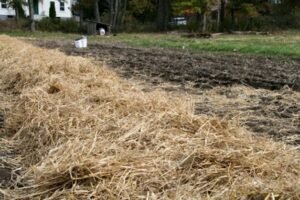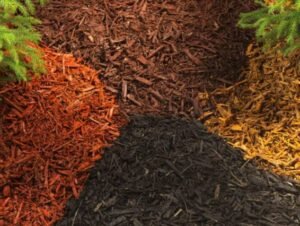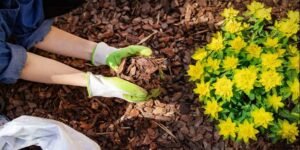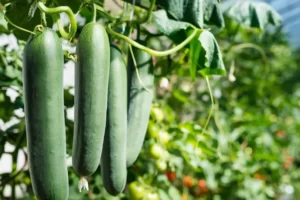What is Mulch? How to use this in your Farm?
Agriculture is a very challenging sector where the farmers always face certain issues which lead them to a very less productivity of their crops. Growing crops is an art and not everyone knows it. Farmers use different methods of farming to enhance the yield but still they have to face certain challenges which causes them to lead a stressful life. In Spite of these farming methods and techniques they still have to protect their crops from pests and diseases, and also they have to take care of their soil a little more because it is very important for the soil to be fertile to make the plants grow properly in the desired manner.

Here in this article, we are going to study about Mulches which are used by the farmers as a cover that not only protect the plants from any harm but also increase the fertility of the soil making them nutrient rich and producing healthy crops.
What is Mulch?
Mulch is a cover material basically made up of sawdust, compost or paper, used by the farmers to spread on the surface of the soil to protect the soil and plants from any harm by reducing evaporation, maintaining soil temperature, preventing from erosion, controlling weeds and enriching the soil to keep the fruits clean and healthy.
Mulches can be either organic like wood chips, leaves, straw, etc or even inorganic like plastics, rocks, etc. Mulches are always layered on the top of the ground and not tilled inside as it can impact negatively.
Materials used in a Mulch
Mulches are made up of a variety of materials based on different factors like:
- availability of the resources
- costs
- appearance
- its effect on soil
- chemical properties
- pH
- durability
- combustibility
- rate of decomposition, if organic etc.
Some of the materials used in mulches are:
- Organic residues – Mulches are made up of organic materials or residues like grasses, leaves, hay, straws, kitchen scraps/wastes, barks, sawdusts, shells, woodchips, newspapers, cardboard, wool, animal manures, etc. These materials help in direct composting as well.
- Compost materials to prevent weeds being introduced by the mulch.
- Recycled rubber tyres for making rubber mulch.
- Plastic sheets for making plastic mulch.
- Old carpets
- Rocks and gravels which help in providing warmth during colder months.
Types of Mulches
Mulches are generally categorized into – Organic and Inorganic (Synthetic).
- Organic Mulches
Organic mulches are made up of organic materials and decompose fast and so they need to be replaced. Organic mulches often form a barrier between soil and atmosphere blocking the water and air flow.

Types of organic mulches:
- Bark, Shredded or Chipped
- Pine needles
- Grass clippings
- Newspaper/ Cardboard
- Shredded leaves
- Straw & Hay
- Wood chips
- Peat moss
- Biodegradable mulch
- Inorganic (Synthetic) Mulch
Synthetic mulches are those mulches which are not alive and are not biodegradable, thus contaminating the soil. They don’t add any nutrients to the soil as organic mulches but require replacement too. These mulches often suppress the weeds effectively reducing the labour and other costs related to weed control.
Types of Synthetic mulches:
- Black Plastic
- Landscape Fabric
- Stone/Gravel
- Polypropylene & Polyethylene mulch
- Carpet
- Colored mulch
Why Mulch ?
Mulch forms a protective barrier between your plants and soil which is made up of a variety of organic materials which can be decomposed and some non organic materials as well. Mulching is the best thing for any farm as it forms a cover for the plants preventing it from internal and external harming factors.

Here we mention some of the benefits of Mulching.
- Control of Weeds – Mulching acts as a barrier, which prevents the weeds from sunlight thereby limiting it.
- Retains Moisture – Mulches absorb water, thus limiting evaporation and helps in returning moisture.
- Prevents Soil Erosion – Mulches keep the absorbed water trapped in the soil and prevent them from washing off through rain waters, thus preventing soil erosion.
- Pest control – Some of the mulches such as cedar bark acts as an insect repellent which helps in controlling the pests.
- Maintenance of Soil nutrients – It enriches the soil by providing it with nutrients through the decaying of the organic materials which also improves the fertility of the soil.
- Encourages Earthworms in the soil – Earthworms help the soil significantly, so when mulches are applied in the soil it creates an environment for these organisms.
- Maintains temperature – It regulates the temperature of the soil by monitoring the temperature conditions. When it is hot, it keeps the soil cool and vice versa.
- Shines up your Farm – Mulches are the easiest fillers which fills the empty spaces on your farm giving it a finishing look. It never competes with other plants and is easy to care for.
Best time for Mulching
Mulching needs to be done specifically which could provide productive benefits and ensure the plant health. It is best to do during Autumn season by spreading the mulch around the newly planted trees, shrubs or some herbaceous perennials. Thick mulch will help in protecting the roots and crown of the plants from frost.
During late winter or early spring, the entire beds or borders could be mulched so as to trap moisture from wet weather ensuring the beds don’t dry out quickly due to the heat of the summer.
How to Mulch?
Mulching requires certain conditions to fulfill and a better preparation beforehand is essential to make it more productive. Organic Mulches conserve water, protect roots of the plants and improve the health of the soil by preserving the soil temperature and maintaining moisture and nutrients and also preventing it from the growth of weeds. Inorganic mulches are less effective at preventing weed growth and preserving the soil, but it adds colour and texture to your farm to give it a finishing look.

Mulches are first to be chosen and then proper procedures are to be followed so that the works are to be intended.
Here we will learn some basic steps / procedures of Mulching.
- First of all select the area to be mulched before starting mulching.
- Design the area of mulching by trimming it.
- Find your type of mulch required for that particular area.
- Get ready with your Mulching tools.
- Make sure the site is clear of weeds where mulches are to be applied and the soil should be moist.
- If the soil doesn’t have enough moisture then water the soil to make it wet because it would be difficult to mulch a dry ground.
- Begin mulching from the soil which has already been weeded and then lay down the thick layer of mulch to limit the growth of weed.
- The mulch should be layered upto 4 to 6 inches so as to fix the weed problem but upto 2 inches is enough for the shady spots.
- The chosen mulch could be spread around plants or across the soil upto 2 inches with a spade, leaving some gaps around the stems of plants and then raking the mulch to finish the leveling.
Discussing the above mentioned steps in detail.

Step 1 : Choosing the right Mulch
- Organic mulch (wood chips, straw, grass clippings, leaves, and compost) is selected for adding nutrients to the farm. When these mulches break down, it naturally adds the nutrients to the soil and it also helps in water retention, weed prevention, and will protect plant roots but it doesn’t protect from pests.
- Inorganic mulches are used for making your farm decorative, preventing weed germination, and helping in retaining moisture but are less effective than organic mulches.
- Purchase enough mulch to cover the flower bed or your farm but don’t apply too much mulch as it would suffocate the plant roots and even kill the plant.
Step 2 : Deciding the time to Mulch
- Apply Organic mulch in early summer or end of spring for best results.
- Winter mulch should be applied in the late fall so as to make the freezing process more gradual and to reduce excessive freeze thaw cycles to provide better results. Both organic and inorganic mulches can be applied for winter mulching.
- Organic mulches should be added to newly planted trees or shrubs so as to add essential nutrients to the soil and protect the new plants from weeds as well. Inorganic mulches are not effective here.
Step 3 : Spreading of the Mulch
- Dig the farm using a spade to pull out the existing weeds as it may grow back. Any type of chemical weed can be used to kill or remove the weeds by following proper procedures and precautions.
- The neighbouring area is also to be dug, making an edge for the mulch to keep it off the grass by using a shovel or manual edger carefully so that no soil tosses into the flowerbed as it may promote grass growth.
- Existing mulch is to be removed or a similar mulch should be dressed on the top.
- The mulch should be added onto the flower bed in small piles at first as too much mulch in one area would suffocate the plant roots.
- The mulch should be raked over the entire area forming an even layer of it.
- Organic mulches should be watered so as to maintain moisture and prevent it from blowing away but don’t over water it as it could be harmful.
- Organic mulches should be replaced every year as it loses its benefits over time.
- Inorganic mulches should also be replaced when it becomes dull or when it is no longer fresh.
Limitations of Mulching
Apart from acting as a protective barrier for the plants, it also has certain limitations which can not be overlooked. Below are some of these challenges.
- It increases new weed species
- It is expensive
- It’s capable of introducing certain pests & diseases which can invade the whole farm as well
- It can end up being toxic to the soil at some instances
Conclusion
Mulch is an essential element that needs to be provided to the soil as it prevents so many harmful factors and promotes better growth of the plants. But it is essential to follow certain steps during the process of Mulching to get desired results. The main benefit of of its to protect soil moisture near the plant root zone as well to maintain soil aeration.




